Submitted:
17 September 2023
Posted:
18 September 2023
You are already at the latest version
Abstract
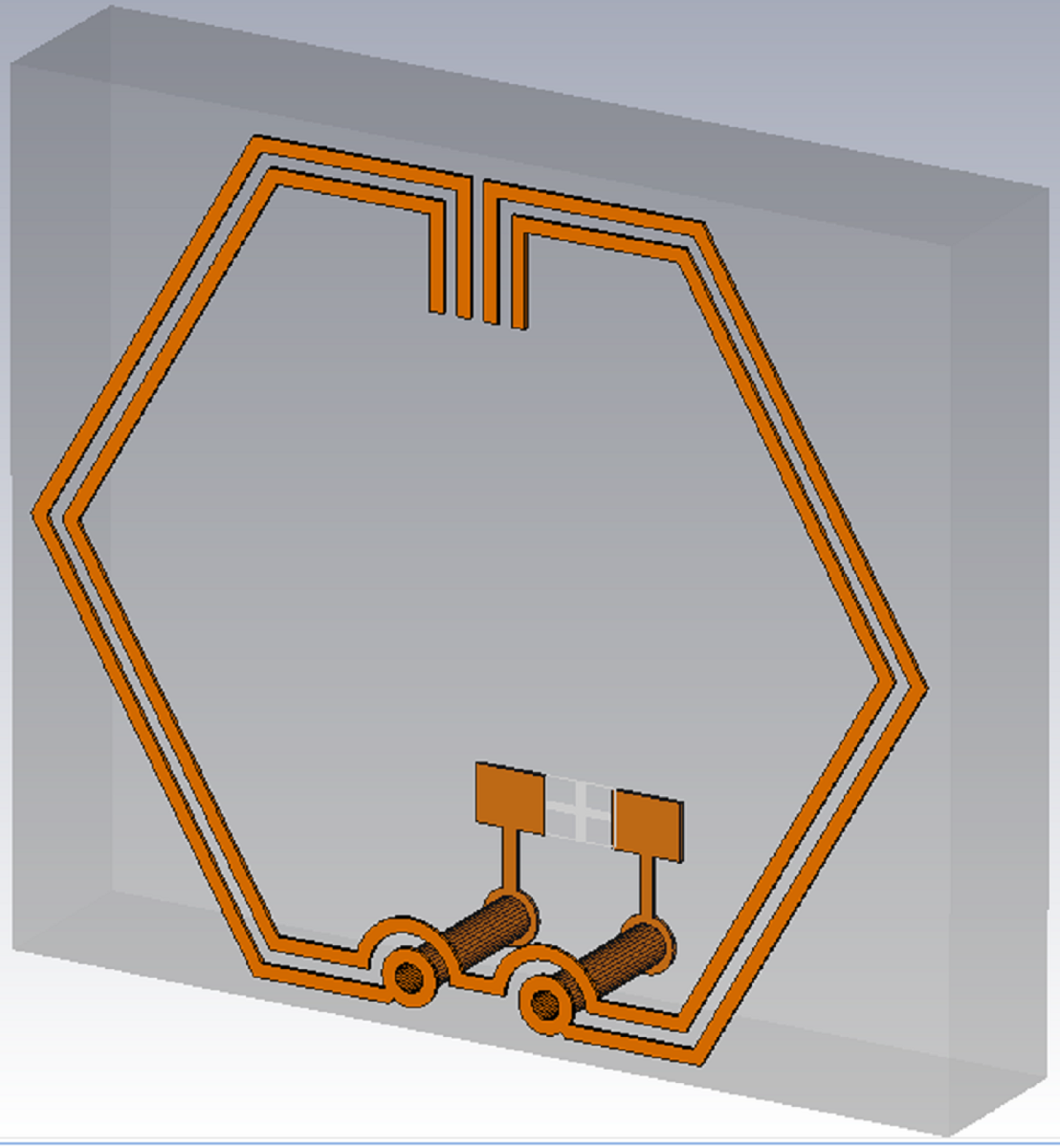
Keywords:
1. Introduction
2. Hexagonal CSRR-Loaded ESA Design
2.1. CSRR Unit Cell Structure
2.2. Design Methodology
2.3. EM Field Distribution
2.4. Simulated Radiation and Network Parameters
2.5. Measured Network Parameters
3. Material Loading on a CSRR-Loaded ESA
3.1. Material Loading Mechanism
3.2. Computational EM Model
3.3. Perturbation Theory
3.4. Experimental Program
3.5. Results and Discussion
4. Extrapolation of Dielectric Parameters
4.1. Perturbation Theory-Inspired Modeling
4.2. Discussion
4. Conclusions
Author Contributions
Funding
Institutional Review Board Statement
Informed Consent Statement
Data Availability Statement
Acknowledgments
Conflicts of Interest
References
- Ali, K.; Nguyen, H.X.; Vien, Q.-T.; Shah, P.; Raza, M.; Paranthaman, V.V.; Er-Rahmadi, B.; Awais, M.; Islam, S.u.; Rodrigues, J.J.P.C. Review and Implementation of Resilient Public Safety Networks: 5G, IoT, and Emerging Technologies. IEEE Network 2021, 35, 18–25. [Google Scholar] [CrossRef]
- Jiang, M.; Cezanne, J.; Sampath, A.; Shental, O.; Wu, Q.; Koymen, O.; Bedewy, A.; Li, J. Wireless Fronthaul for 5G and Future Radio Access Networks: Challenges and Enabling Technologies. IEEE Wireless Communications 2022, 29, 108–114. [Google Scholar] [CrossRef]
- Hoh, W.S.; Ong, B.; Leong, W.Y.; Yoon, S. 5G network review and challenges. In The Nine Pillars of Technologies for Industry 4.0; Leong, W.Y., Chuah, J.H., Tee, B.T., Eds.; IET Telecommunications: Stevenage, United Kingdom, 2020; Chap. 24; pp. 499–519. [Google Scholar]
- Elkorany, A.S.; Mousa, A.N.; Ahmad, S.; Saleeb, D.A.; Ghaffar, A.; Soruri, M.; Dalarsson, M.; Alibakhshikenari, M.; Limiti, E. Implementation of a Miniaturized Planar Tri-Band Microstrip Patch Antenna for Wireless Sensors in Mobile Applications. Sensors 2022, 22, 667. [Google Scholar] [CrossRef] [PubMed]
- Mehmood, Y.; Ahmad, F.; Yaqoob, I.; Adnane, A.; Imran, M.; Guizani, S. Internet-of-Things-Based Smart Cities: Recent Advances and Challenges. IEEE Communications Magazine 2017, 55, 16–24. [Google Scholar] [CrossRef]
- Barker, O. Realizing the Promise of the Internet of Things in Smart Buildings. Computer 2020, 53, 76–79. [Google Scholar] [CrossRef]
- Lee, H.-C.; Ke, K.-H. Monitoring of Large-Area IoT Sensors Using a LoRa Wireless Mesh Network System: Design and Evaluation. IEEE Transactions on Instrumentation and Measurement 2018, 67, 2177–2187. [Google Scholar] [CrossRef]
- Liu, H.; Cheng, Y.; Yan, M. Electrically Small Loop Antenna Standing on Compact Ground in Wireless Sensor Package. IEEE Antennas and Wireless Propagation Letters 2016, 15, 76–79. [Google Scholar] [CrossRef]
- Jin, X.; Ali, M. Embedded Antennas In Dry And Saturated Concrete For Application In Wireless Sensors. Progress in Electromagnetics Research-pier 2010, 102, 197–211. [Google Scholar] [CrossRef]
- Chu, J. Physical limitations of omni-directional antennas. Journal of Applied Physics 1948, 10, 1163–1175. [Google Scholar] [CrossRef]
- Wheeler, H.A. Fundamental Limitations of Small Antennas. Proceedings of the IRE 1947, 35, 1479–1484. [Google Scholar] [CrossRef]
- Wheeler, H.A. The Radiansphere around a Small Antenna. Proceedings of the IRE 1959, 47, 1325–1331. [Google Scholar] [CrossRef]
- Harrington, R.F. Effect of antenna size on gain bandwidth and efficiency. Journal of Research of the National Bureau of Standards-D. Radio Propagation 1960, 64D. [Google Scholar] [CrossRef]
- Rabbani, M.S.; Churm, J.; Feresidis, A. Metamaterial antennas for 5G and beyond. In Antennas and Propagation for 5G and Beyond; Abbasi, Q.H., Jilani, S.F., Alomainy, A., Imran, M.A., Eds.; IET Telecommunications: Stevenage, United Kingdom, 2020; Chap. 3; pp. 35–65. [Google Scholar]
- Sun, K.; Han, S.; Choi, J.H.; Lee, J.K. Miniaturized Active Metamaterial Resonant Antenna With Improved Radiation Performance Based on Negative-Resistance-Enhanced CRLH Transmission Lines. IEEE Antennas and Wireless Propagation Letters 2018, 17, 1162–1165. [Google Scholar] [CrossRef]
- Pendry, J.B.; Holden, A.J.; Robbins, D.J.; Stewart, W.J. Magnetism from conductors and enhanced nonlinear phenomena. IEEE Transactions on Microwave Theory and Techniques 1999, 47, 2075–2084. [Google Scholar] [CrossRef]
- Falcone, F.; Lopetegi, T.; Baena, J.D.; Marques, R.; Martin, F.; Sorolla, M. Effective negative-/spl epsiv/ stopband microstrip lines based on complementary split ring resonators. IEEE Microwave and Wireless Components Letters 2004, 14, 280–282. [Google Scholar] [CrossRef]
- Fallahpour, M.; Zoughi, R. Antenna Miniaturization Techniques: A Review of Topology-and Material-Based Methods. IEEE Antennas and Propagation Magazine 2018, 60, 38–50. [Google Scholar] [CrossRef]
- Reddy, A.N.; Raghavan, S. Split ring resonator and its evolved structures over the past decade: This paper discusses the nuances of the most celebrated composite particle (split-ring resonator) with which novel artificial structured materials (called metamaterials) are built. In Proceedings of the 2013 IEEE International Conference ON Emerging Trends in Computing, Communication and Nanotechnology (ICECCN), Tirunelveli, India, 25–26 March 2013. [Google Scholar]
- Ferrero, F.; Chevalier, A.; Ribero, J.M.; Staraj, R.; Mattei, J.L.; Queffelec, Y. A New Magneto-Dielectric Material Loaded, Tunable UHF Antenna for Handheld Devices. IEEE Antennas and Wireless Propagation Letters 2011, 10, 951–954. [Google Scholar] [CrossRef]
- Song, C.; Bennett, E.L.; Xiao, J.; Hua, Q.; Xing, L.; Huang, Y. Compact Ultra-Wideband Monopole Antennas Using Novel Liquid Loading Materials. IEEE Access 2019, 7, 49039–49047. [Google Scholar] [CrossRef]
- Jin, X.; Ali, M. Embedded Antennas In Dry And Saturated Concrete For Application In Wireless Sensors. Progress in Electromagnetics Research-pier 2010, 102, 197–211. [Google Scholar] [CrossRef]
- Sum, Y.L.; Rheinheimer, V.; Soong, B.H.; Monteiro, P.J.M. Effect of iron (III) oxide concentration on the performance of meta-resonators embedded in cementitious matrix. Cement and Concrete Composites 2021, 116, 103890. [Google Scholar] [CrossRef]
- Barrett, J.P.; Cummer, S.A. Design and Full Characterization of Planar Active Magnetic RF Metamaterials. IEEE Antennas and Wireless Propagation Letters 2015, 14, 943–946. [Google Scholar] [CrossRef]
- Sum, Y.L.; Rheinheimer, V.; Soong, B.H.; Monteiro, P.J.M. Scalable 2.45 GHz electrically small antenna design for metaresonator array. The Journal of Engineering 2017, 5, 170–174. [Google Scholar] [CrossRef]
- Zhang, Y.H.; Spiegel, R.J.; Fan, Y.; Joines, W.Y.; Liu, Q.H.; Da Xu, K. Design of a Stub-Loaded Ring-Resonator Slot for Antenna Applications. IEEE Transactions on Antennas and Propagation 2015, 63, 517–524. [Google Scholar] [CrossRef]
- Gay-Balmaz, P.; Martin, O. Electromagnetic resonances in individual and coupled split-ring resonators. Journal of Applied Physics 2003, 92, 2929–2936. [Google Scholar] [CrossRef]
- Choi, J.; Oh, S.; Jo, S.; Yoon, W.-S.; Lee, J. Vertical Split Ring Resonator Using Vias With Wide Bandwidth and Small Electrical Size. IEEE Microwave and Wireless Components Letters 2017, 27, 16–18. [Google Scholar] [CrossRef]
- Bahl, I.; Bhartia, P. Microwave Solid State Circuit Design, 2nd ed.; John Wiley & Sons: Hoboken, NJ, USA, 2003. [Google Scholar]
- Wartak, M.S.; Tsakmakidis, K.L.; Hess, O. Introduction to metamaterials. Physics in Canada 2011, 67, 30–34. [Google Scholar]
- Harrington, R.F. Time-Harmonic Electromagnetic Fields, 2nd ed.; Wiley-IEEE Press: New York, 2001. [Google Scholar]
- Jackson, J.D. Classical Electrodynamics, 3rd ed.; John Wiley & Sons: Hoboken, NJ, 2003. [Google Scholar]
- Smith, W.E. The energy storage of a prescribed impedance. Proceedings of the Royal Society of New South Wales 1969, 102, 203–218. [Google Scholar] [CrossRef]
- Muqaibel, A.; Safaai-Jazi, A.; Bayram, A.; Attiya, A.M.; Riad, S.M. Ultrawideband through-the-wall propagation. IEE Proc.-Microwaves, Antennas and Propagation 2005, 152, 581–588. [Google Scholar] [CrossRef]
- Mehta, P.K.; Monteiro, P.J.M. Concrete: Microstructure, Properties, and Materials, 4th ed; McGraw-Hill Education: New York, USA, 2014. [Google Scholar]
- Pozar, D.M. Microwave Engineering, 4th ed.; John Wiley & Sons: Hoboken, NJ, USA, 2012. [Google Scholar]
- Wu, C.F.J.; Hamada, M.S. Experiments: Planning, Analysis, and Optimization, 2nd edn; Wiley: New York, USA, 2009; pp. 45–86. [Google Scholar]
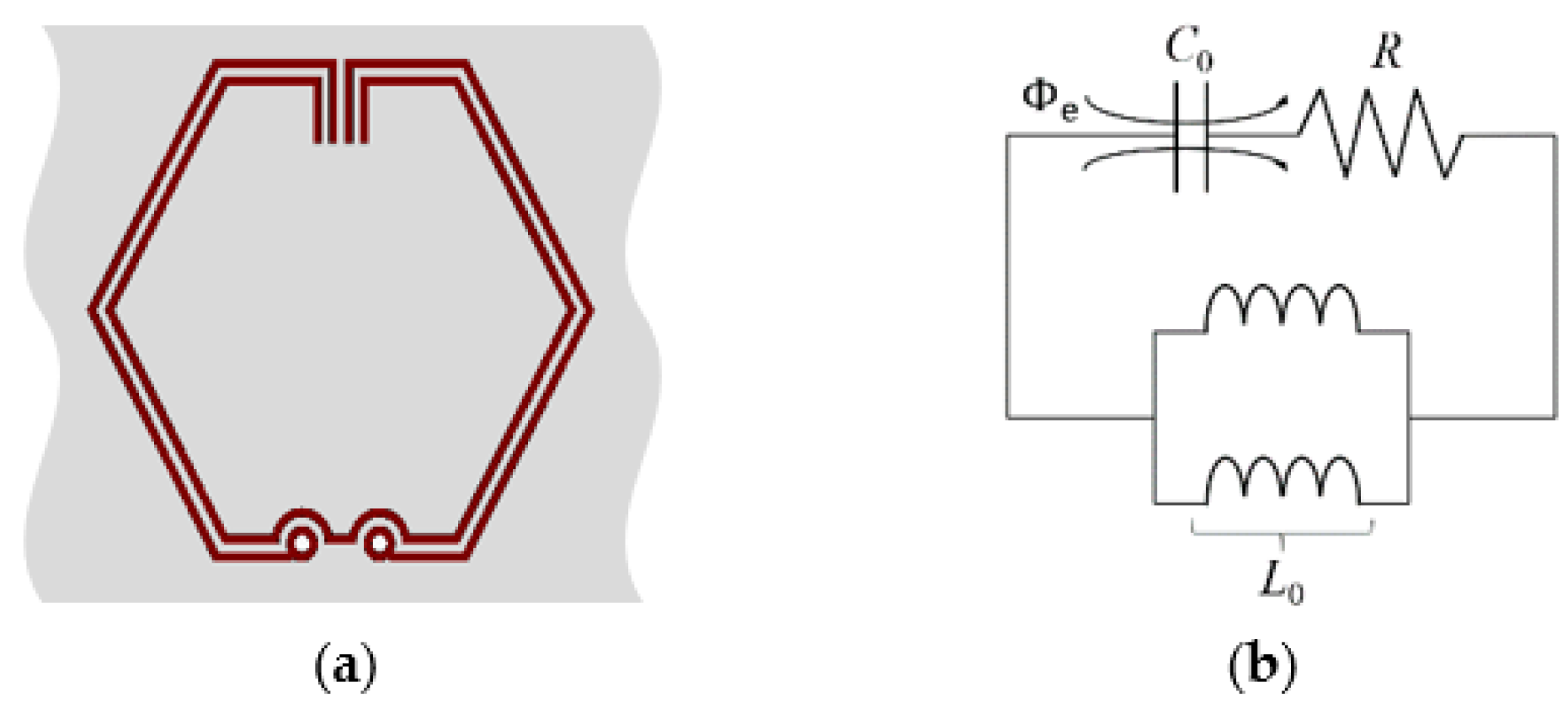
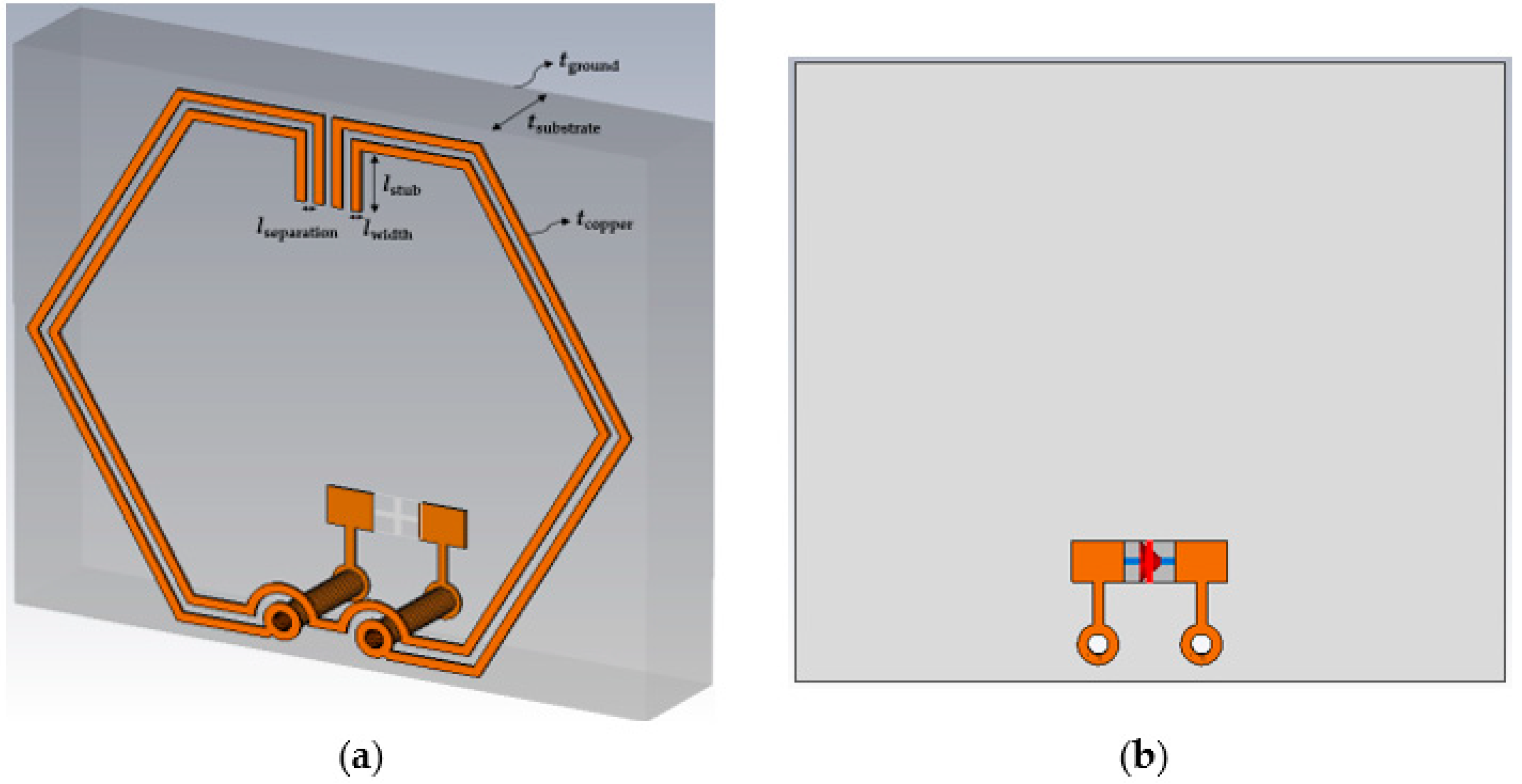
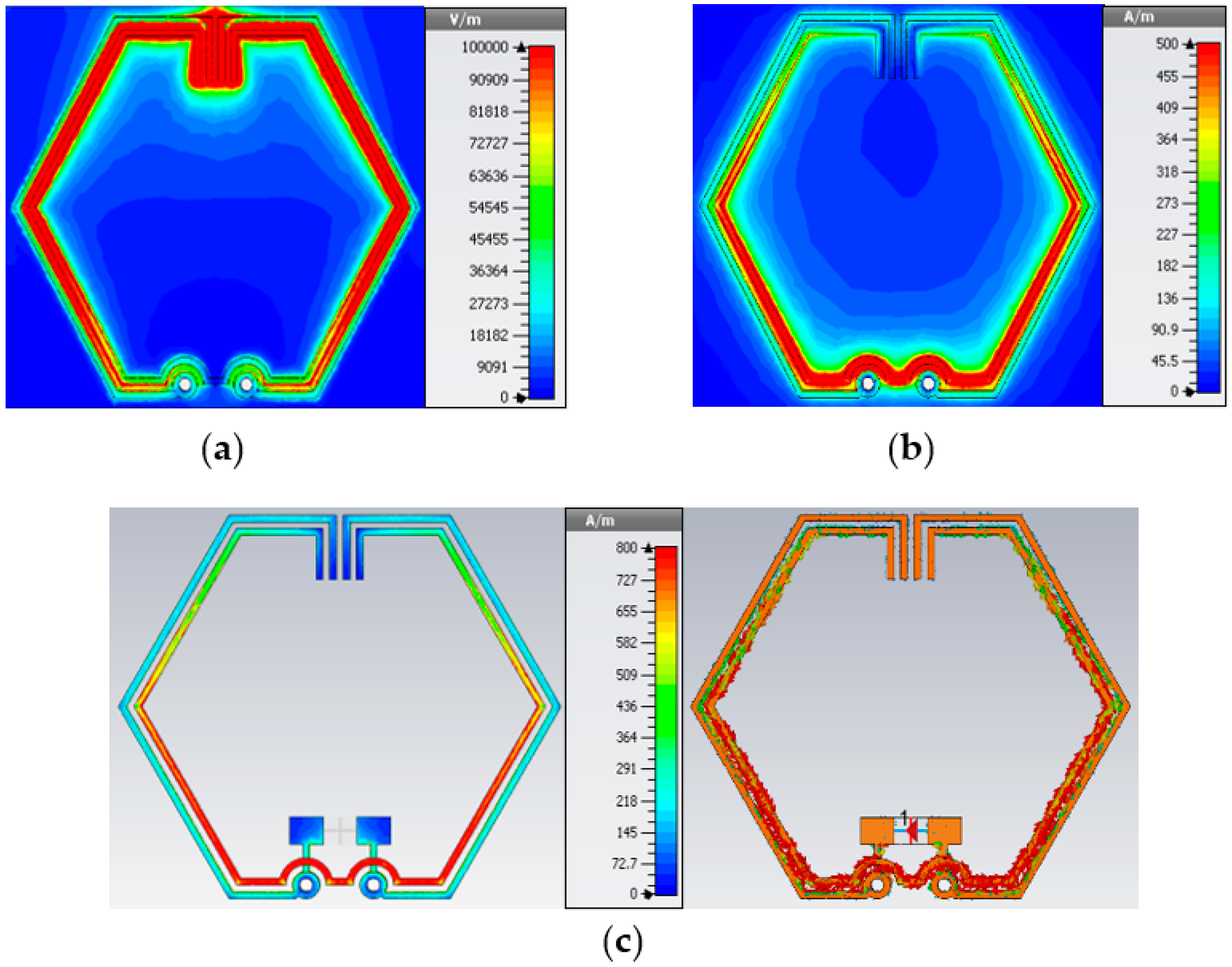
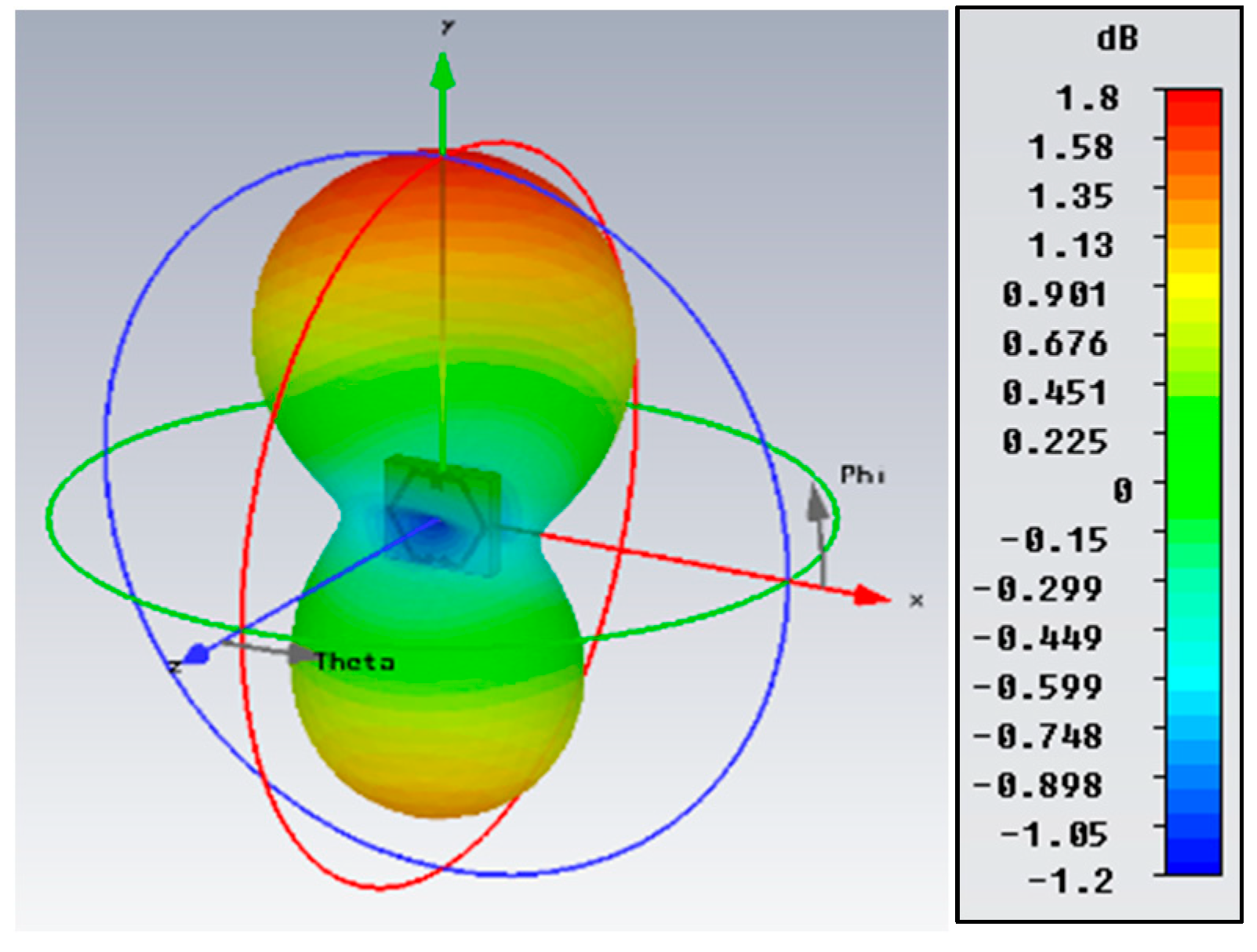
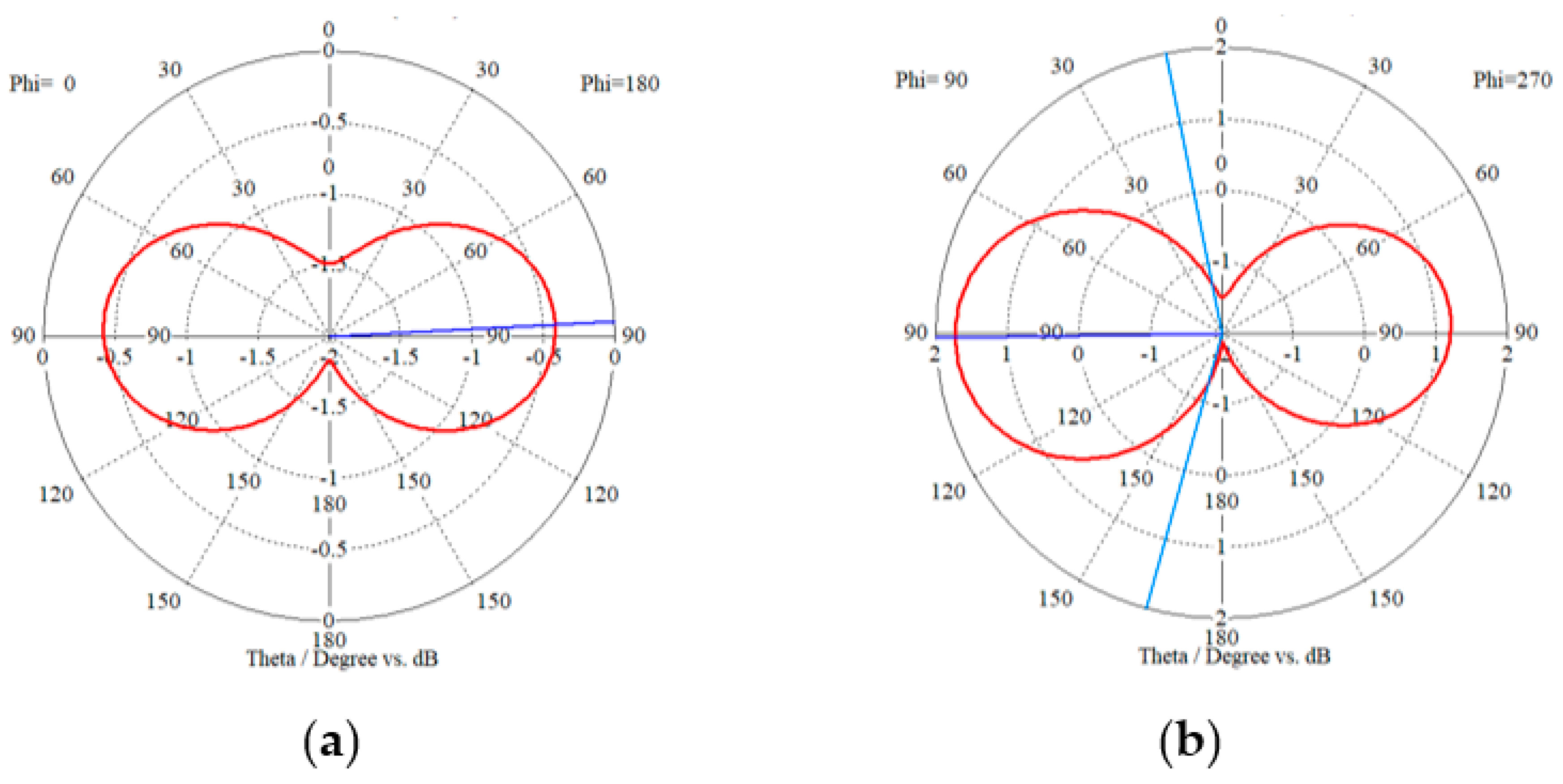
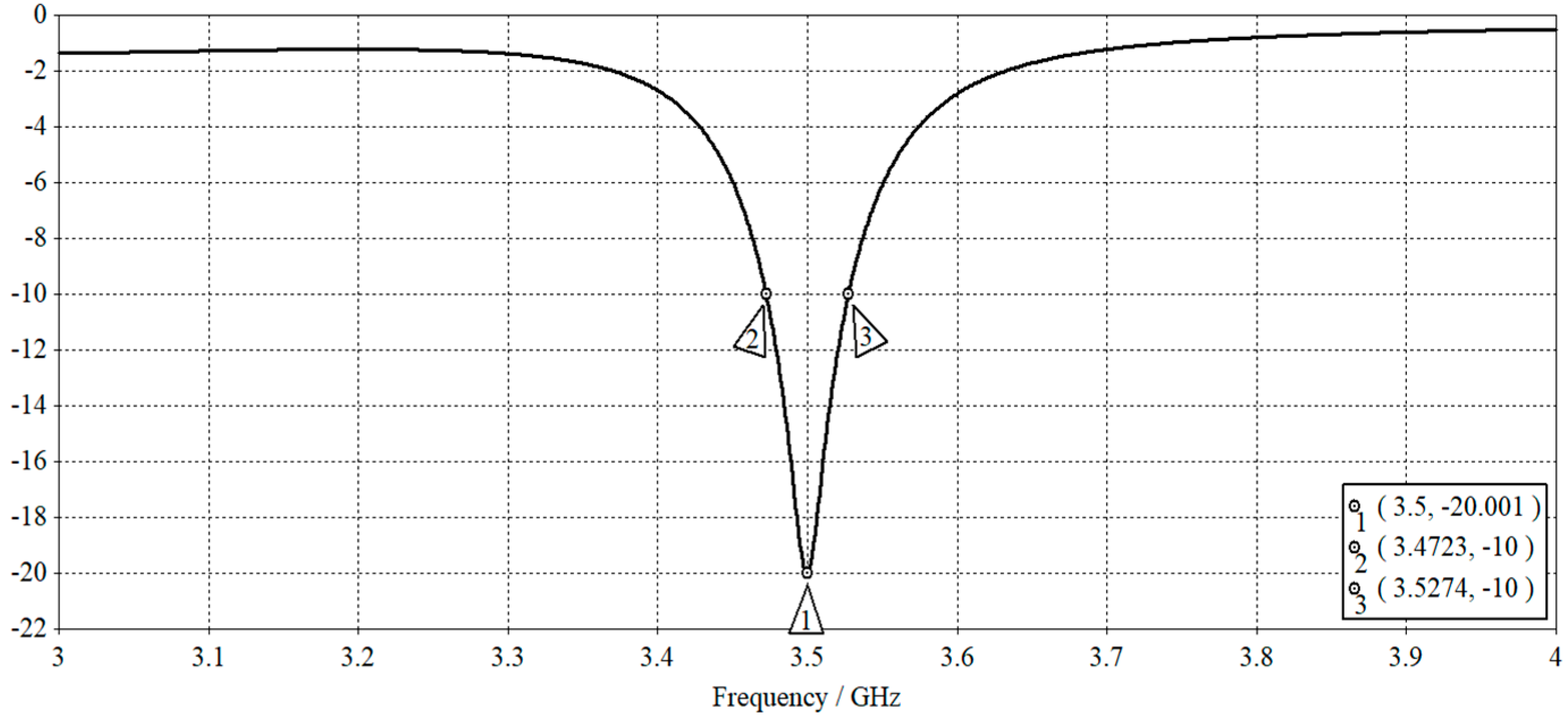
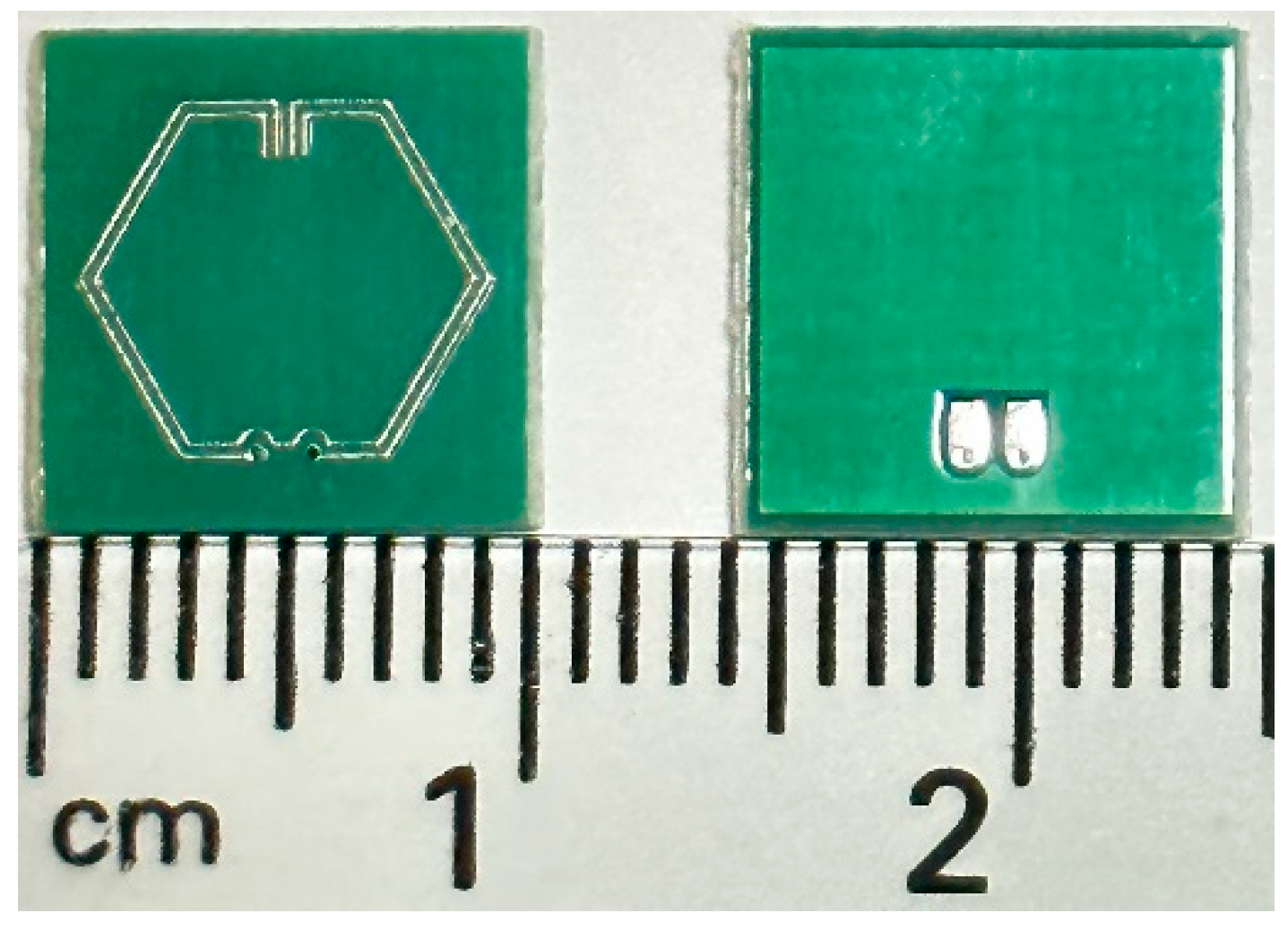

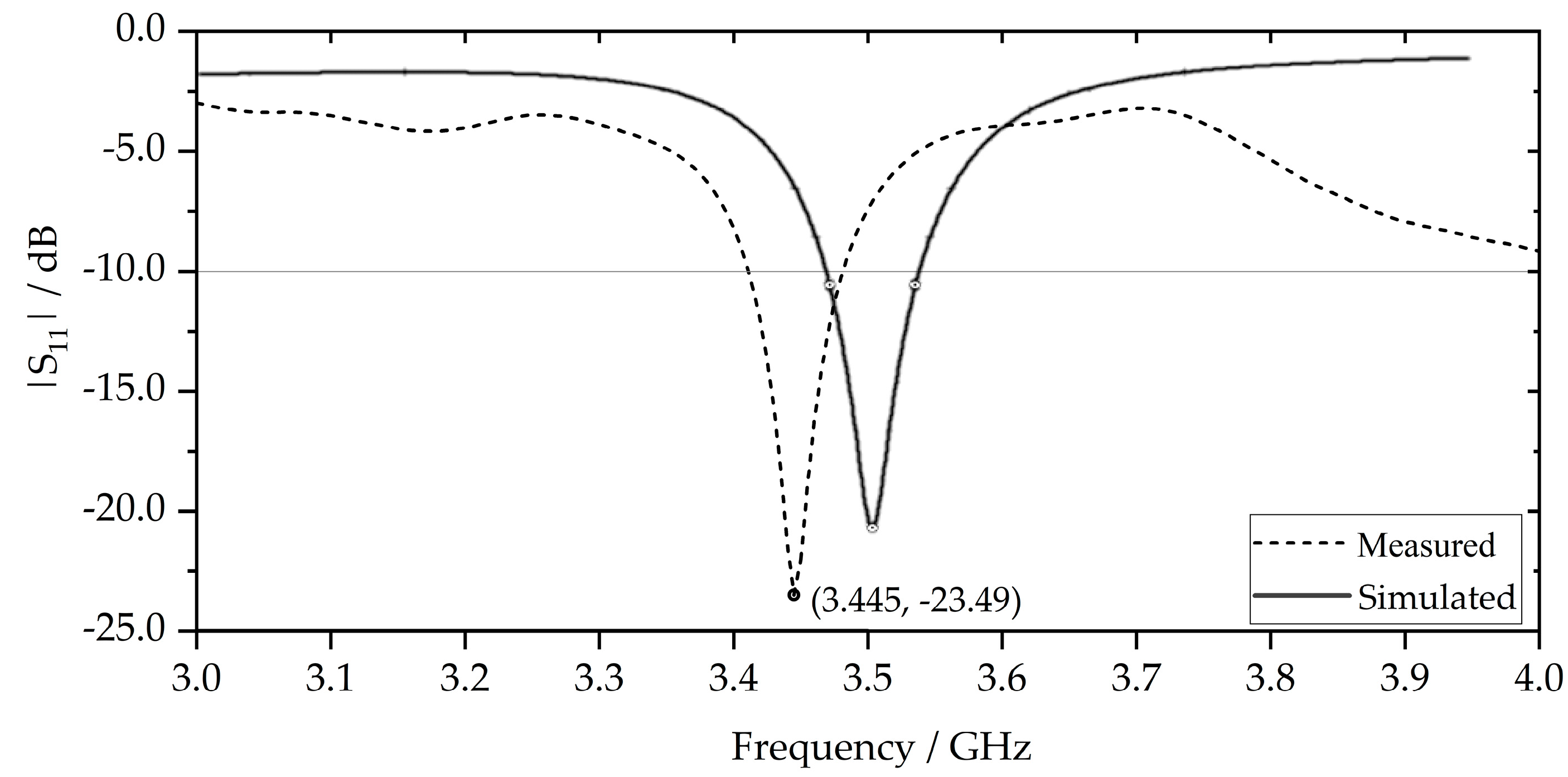
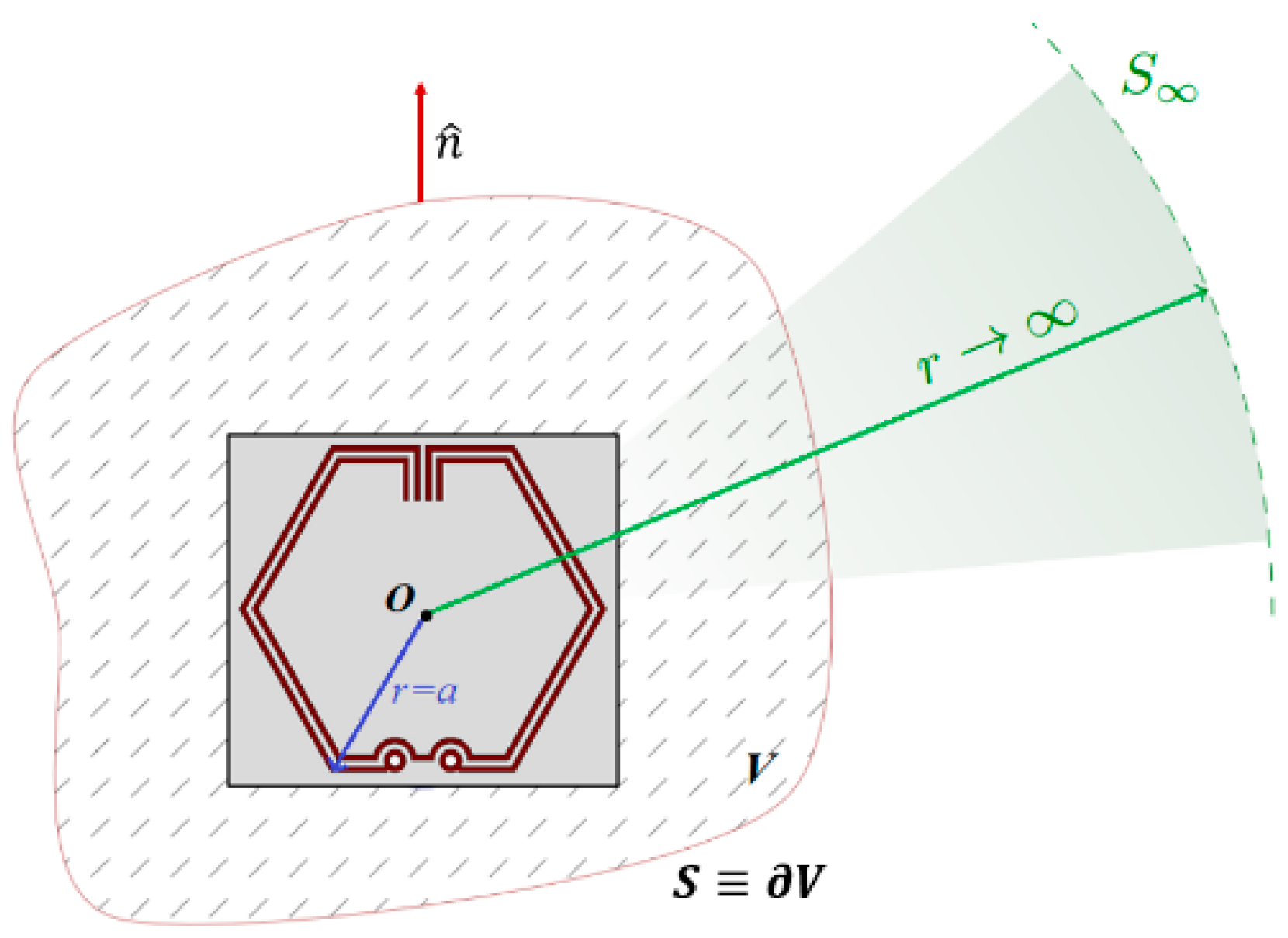
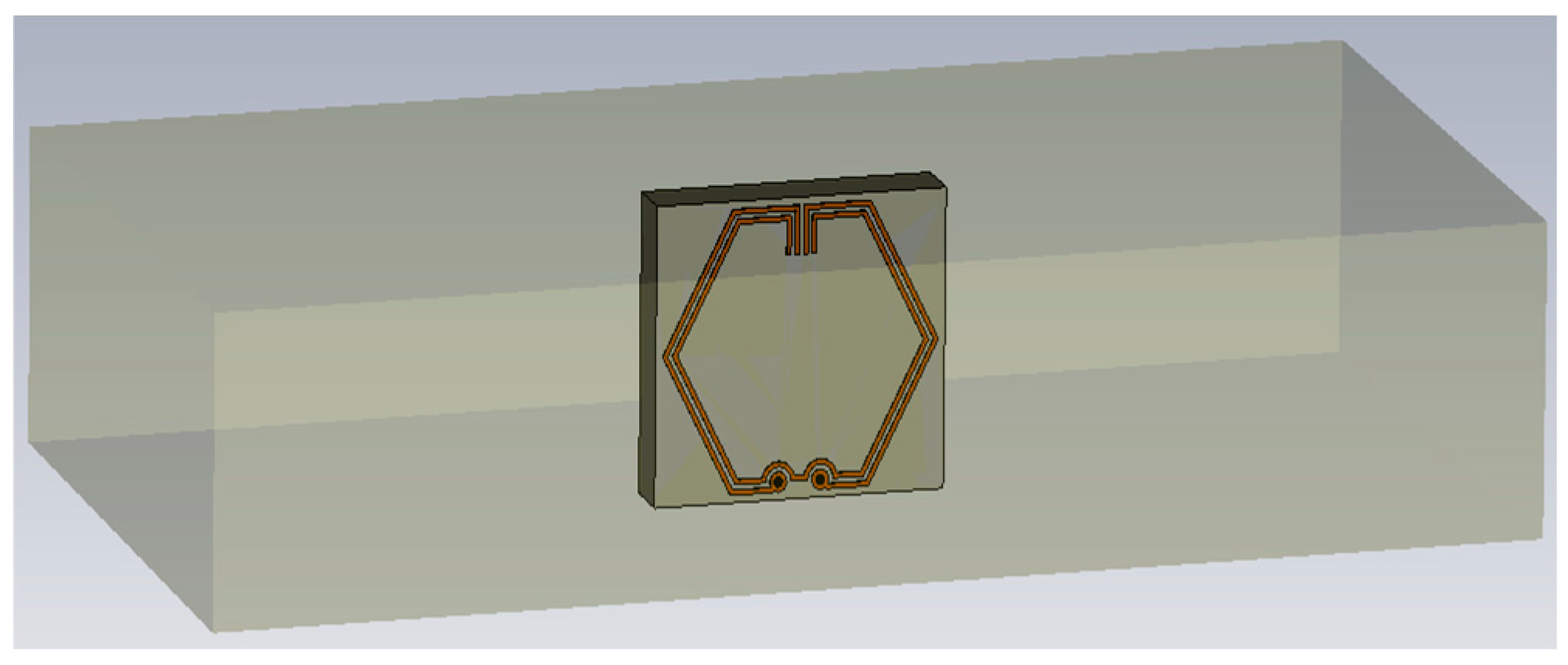
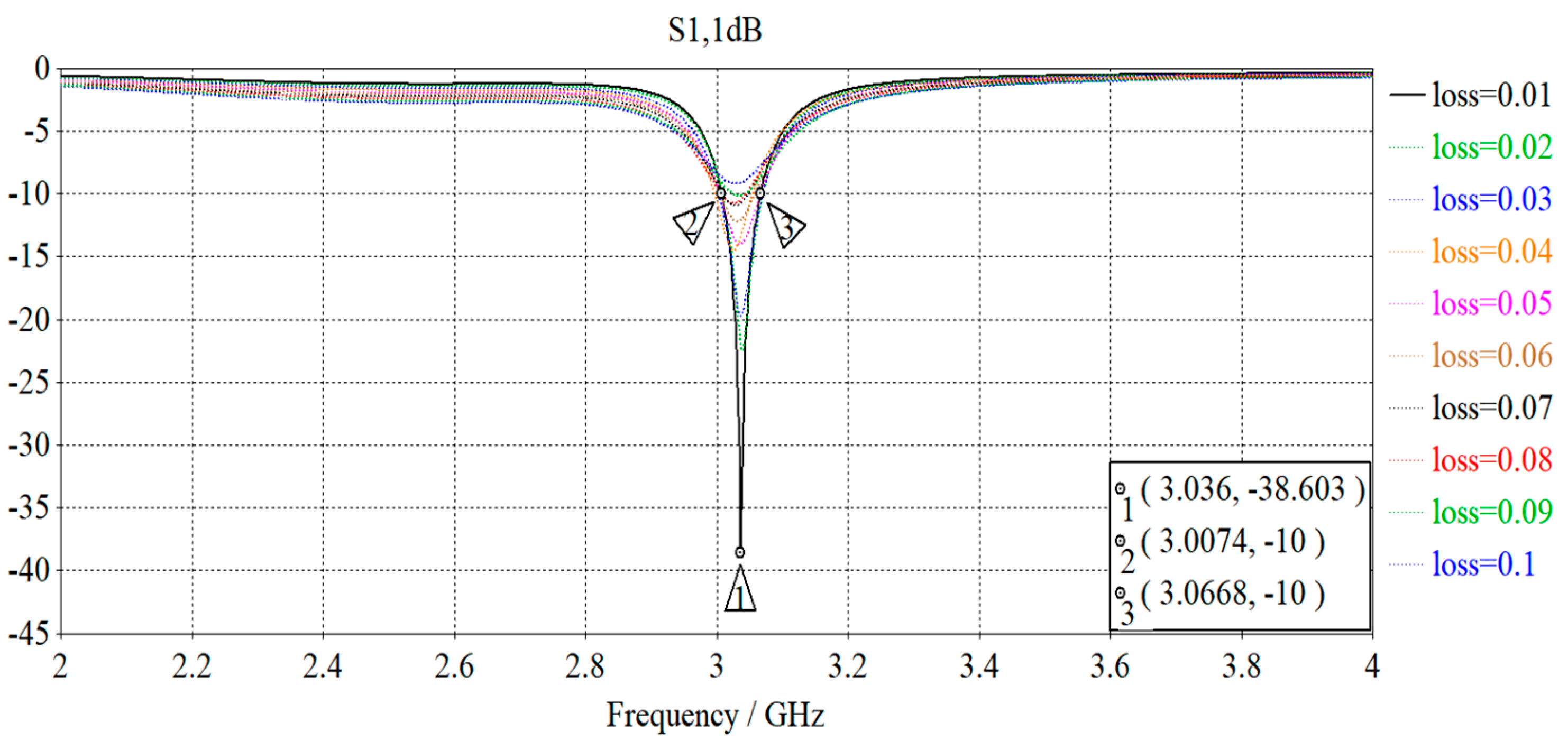
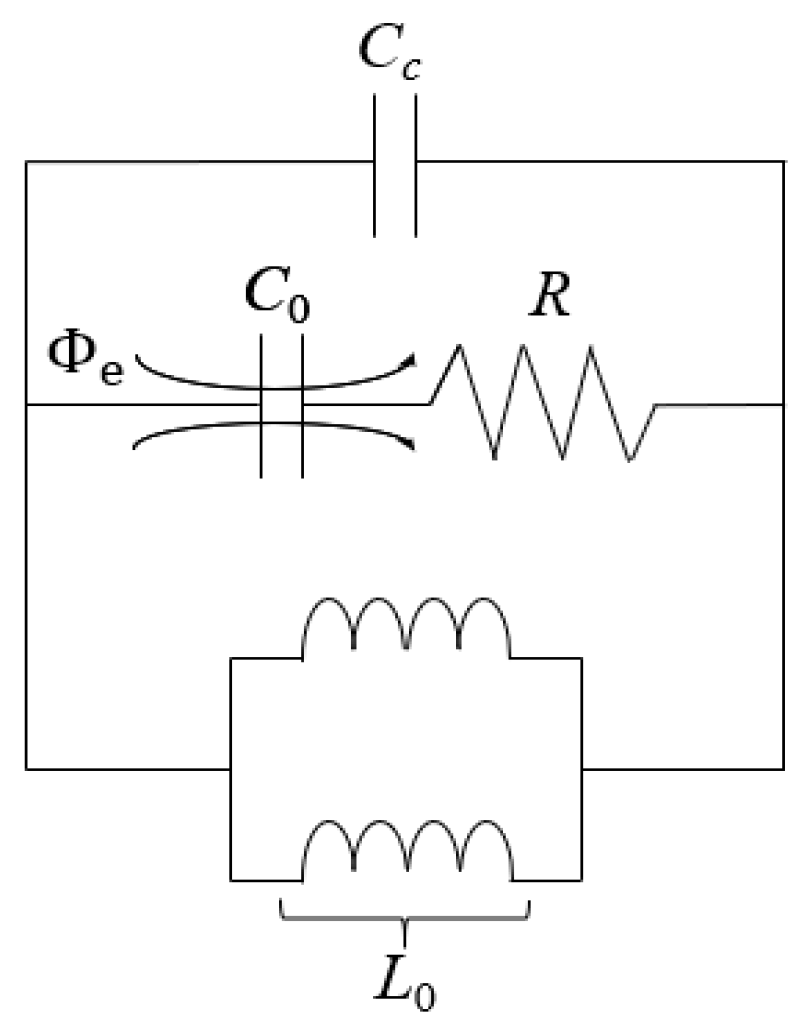
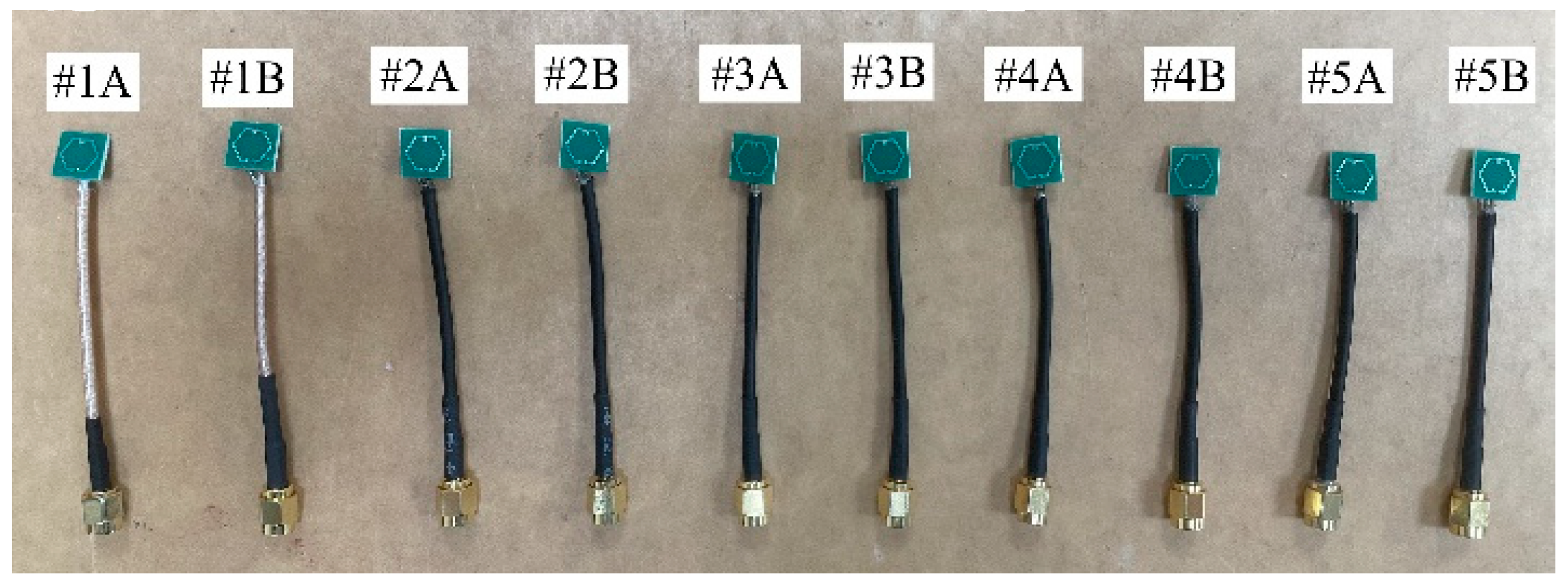

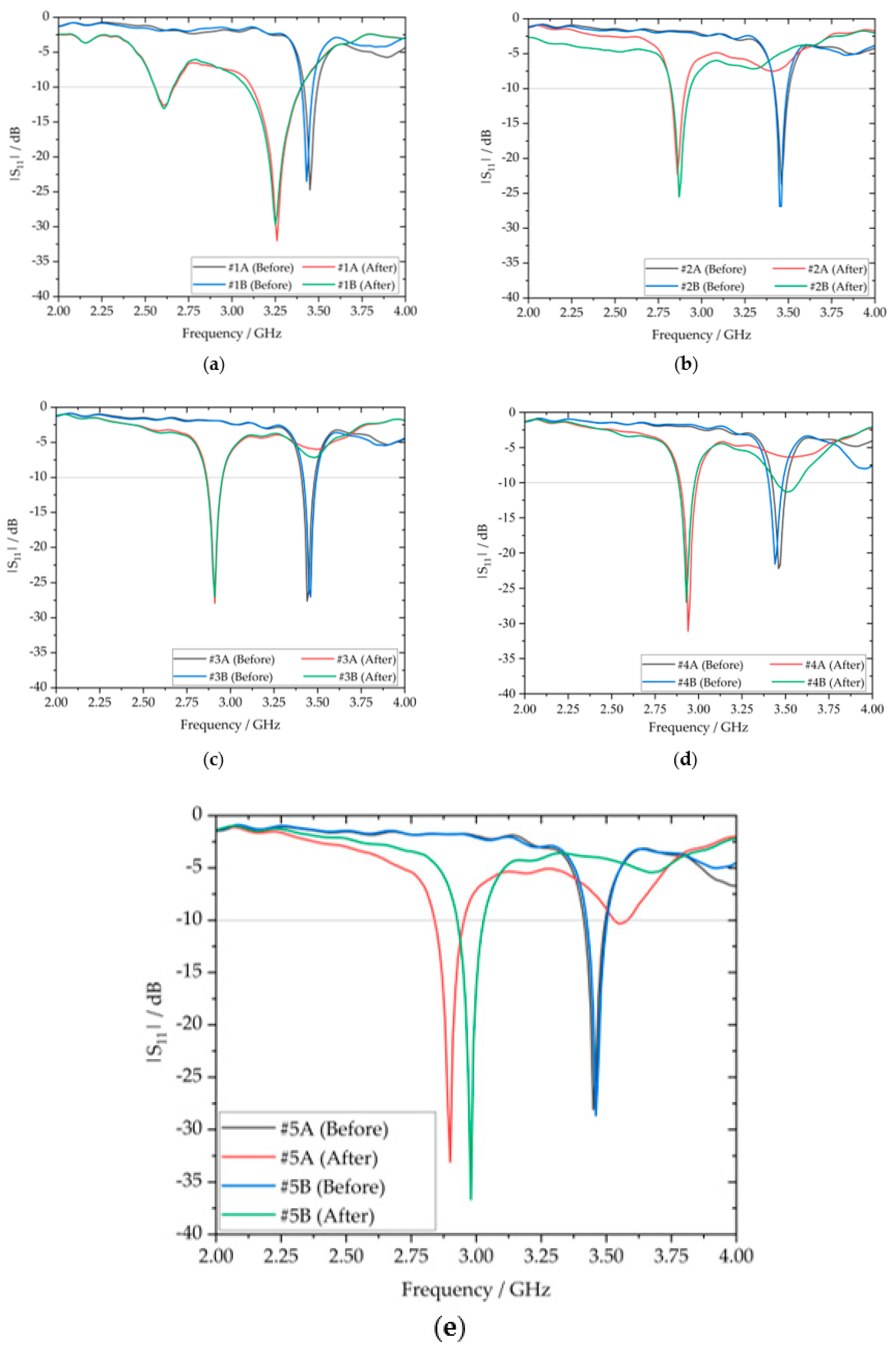

| Design Parameter | Symbol | Value |
|---|---|---|
| Maximum cell dimension (@ 3.50 GHz) | 8.57 mm | |
| Substrate thickness | tsubstrate | 1.60 mm (63 mils) |
| Ground plane thickness | tground | 0.0178 mm (0.5 oz) |
| Copper thickness | tcopper | 0.0178 mm (0.5 oz) |
| Width of copper trace | lwidth | 0.127 mm (5 mils) |
| Trace separation/clearance | lseparation | 0.127 mm (5 mils) |
| Through-hole via inner radius | lradius,in | 0.127 mm (5 mils) |
| Annular ring outer radius | lradius,out | 0.254 mm |
| Optimized stub length | lstub | 0.83 mm |
| Trace characteristic impedance | - | 50 Ω |
| f0 / GHz | |S11| / dB | VSWR | BW / GHz | FBW / % | Q |
|---|---|---|---|---|---|
| 3.50 | -20 .0 | 1.22 | 0.055 | 1.57 | 63.5 |
| f0 / GHz | |S11| / dB | VSWR | BW / GHz | FBW / % | Q |
|---|---|---|---|---|---|
| 3.445 | -23.49 | 1.15 | 0.07 | 2.03 | 49.2 |
| Parameter/Constituents | Level(s) | Mass of constituents (kg/m3) | Sample # |
|---|---|---|---|
| Cement type (control) | OPC CEM I | 1222 | - |
| Water (control) | w/c = 0.50 | 611 | - |
| Weight percentage of Fe2O3 | 0-wt% 1-wt% 2-wt% 3-wt% 4-wt% |
0.0 12.2 24.4 36.6 48.8 |
#1A, #1B #2A, #2B #3A, #3B #4A, #4B #5A, #5B |
| MUT | f0 / GHz | f1 / GHz | Δf / GHz | S.R. | |S11, before|/dB | |S11, after|/dB | Δ|S11|/dB |
|---|---|---|---|---|---|---|---|
| #1A | 3.45 | 3.26 | -0.19 | -5.51 % | -24.7 | -32.0 | -7.3 |
| #1B | 3.43 | 3.25 | -0.18 | -5.25 % | -23.5 | -29.7 | -6.2 |
| #2A | 3.46 | 2.88 | -0.58 | -16.8 % | -23.7 | -23.2 | +0.5 |
| #2B | 3.45 | 2.87 | -0.58 | -16.8 % | -26.9 | -25.5 | +1.4 |
| #3A | 3.44 | 2.91 | -0.53 | -15.4 % | -27.6 | -27.9 | -0.3 |
| #3B | 3.46 | 2.91 | -0.55 | -15.9 % | -27.0 | -27.1 | -0.1 |
| #4A | 3.46 | 2.94 | -0.52 | -15.0 % | -22.2 | -31.1 | -8.9 |
| #4B | 3.44 | 2.93 | -0.51 | -14.8 % | -21.6 | -27.0 | -5.4 |
| #5A | 3.44 | 2.92 | -0.52 | -15.1 % | -28.1 | -33.8 | -5.7 |
| #5B | 3.46 | 2.98 | -0.48 | -13.9 % | -28.6 | -36.7 | -8.1 |
| MUT | Dielectric Embedding Material | | | (relative) | |
|---|---|---|---|---|
| - | Simulation-defined | +0.26 | 2.20 | - |
| #1A | OPC/ 0-wt% Fe2O3 | +0.11 | 2.05 | Low |
| #1B | OPC/ 0-wt% Fe2O3 | +0.10 | 2.04 | Low |
| #2A | OPC / 1-wt% Fe2O3 | +0.33 | 2.27 | High |
| #2B | OPC / 1-wt% Fe2O3 | +0.33 | 2.27 | High |
| #3A | OPC / 2-wt% Fe2O3 | +0.30 | 2.24 | High |
| #3B | OPC / 2-wt% Fe2O3 | +0.31 | 2.25 | High |
| #4A | OPC / 3-wt% Fe2O3 | +0.29 | 2.23 | Low |
| #4B | OPC / 3-wt% Fe2O3 | +0.29 | 2.23 | Low |
| #5A | OPC / 4-wt% Fe2O3 | +0.29 | 2.23 | Low |
| #5B | OPC / 4-wt% Fe2O3 | +0.27 | 2.21 | Low |
Disclaimer/Publisher’s Note: The statements, opinions and data contained in all publications are solely those of the individual author(s) and contributor(s) and not of MDPI and/or the editor(s). MDPI and/or the editor(s) disclaim responsibility for any injury to people or property resulting from any ideas, methods, instructions or products referred to in the content. |
© 2023 by the authors. Licensee MDPI, Basel, Switzerland. This article is an open access article distributed under the terms and conditions of the Creative Commons Attribution (CC BY) license (http://creativecommons.org/licenses/by/4.0/).





